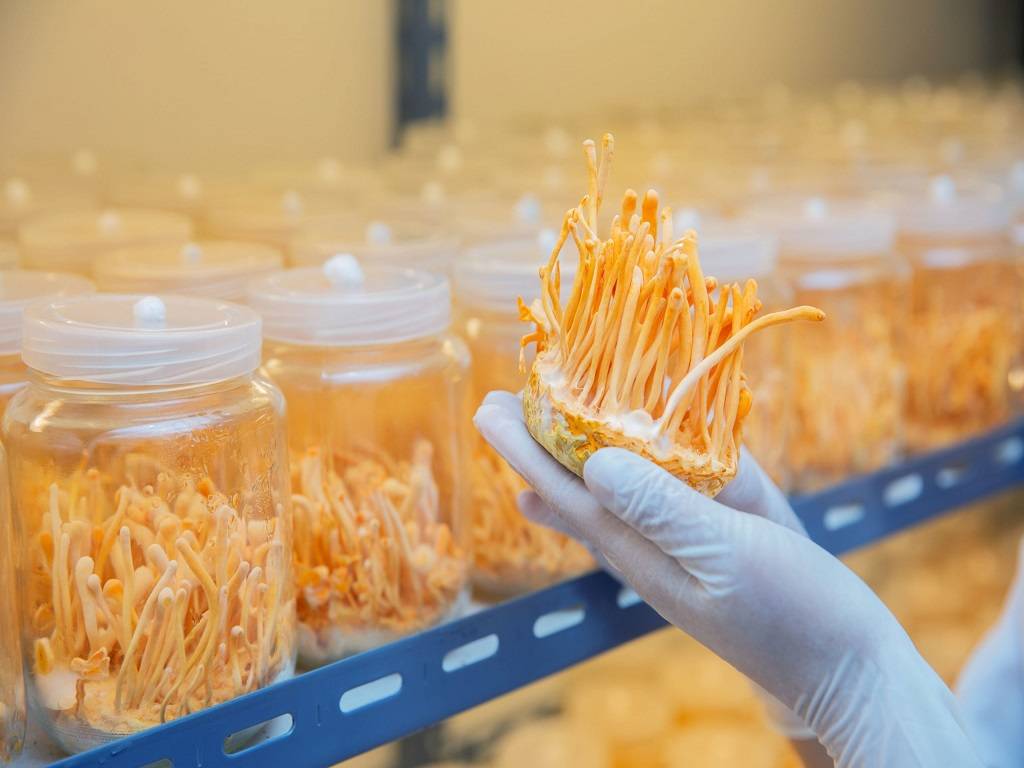
Because of its medicinal characteristics, C. sinensis is the most significant species, and it may be found in upper levels of the Himalayas (Nepal, Bhutan, and Tibet, as well as bordering areas of India and China) at elevations ranging from 3000 to 5500 metres.
As it is already known C. sinensis parasitizes ghost moth larvae. This fungus may grow on a wide range of artificial substrates. Also, ghost moth larvae have been successfully reared. Its cultivation began in China in 2013. Large-scale man-made cultivation was recently accomplished, with 10 tonnes of this fungus grown in China in 2016.
It may be grown at 24 °C in a liquid medium containing 1.25% glucose, 1.25% sucrose, 0.02% peptone, 0.0625% yeast powder, 0.025% KH2PO4, 0.0125% MgSO4.7H2O, 0.0025% Vit B1, and natural pH. Based on DNA research, it was shown to be distinct from other Cordyceps species and was called Ophiocordyceps sinensis. The cultivation of another species, Cordyceps militaris.
Lab and Culture Preparation of Cordyceps militarist
C. militaris is grown in a laboratory setting where temperature, humidity and filtered fresh air are all controlled. Cultivation is done in jars stored on racks, similar to how we keep bags or bottles in a spawn lab. It is grown at a temperature of 16 degrees Celsius. It fruits well at temperatures between 24°C and 800- 1000 lux. Relative humidity of 70-80% is required during cultivation.
The Potato Dextrose Agar (PDA) medium is used to keep the culture alive and multiply it. To create PDA, peel 250 g potatoes and cut them into little pieces. Boil 200 g diced potatoes in 1 litre of distilled water for 15- 20 minutes, or until potatoes are semi-soft. Sieve it, then add 20 g dextrose and 14 g agar to get a clear solution. Boil it, then pour it into test tubes, autoclave it, and make slants.
Pure cultures of this mushroom can be obtained from the outside or grown from the fruiting body using the tissue culture method.
Cultures are maintained in the dark for 8-10 days to allow mycelium to spread. Because mycelium grows in the dark, it will be pure white in colour. When exposed to light for 4-5 days, it becomes orange. It could be further replicated for use in liquid culture preparation.
Substrate Preparation
The first step in the preparation of the substrate is the preparation of the nutrient solution. For this, we add the following in 1000 ml distilled water.
-
Glucose - 20 g
-
Peptone - 5 g
-
Yeast extract - 3 g
-
KH2PO4 - 2 g
-
MgSO4 - 0.5 g
-
Tri Ammonium Citrate (TCA) - 1 g
-
Vit B1 - 50 mg
-
Vit B12 - 10 mg
-
Multivitamin - 10 mg
There are different formulas for nutritious medium preparation in which the quantities of the above elements change and potato extract, silkworm larvae powder, or herbal eggs are added together with additional ingredients such as glucose, peptone, MgSO4, yeast extract, vitamin B1, and so forth. Vit B1 is a vital element in all combinations.
Cultivation
After being inoculated with liquid spawn, the jars are stored in the dark for 8-10 days at 20- 22°C and RH 65-70%. To produce gloomy conditions, wrap jars with dark polythene or fabric. Mycelium grows in the medium and spreads due to its development in the dark and is seen as white in colour. After the substrate has been completely colonized, the jars are exposed to light for a week until the colour of the mycelium becomes orange.
After we expose the colonization substrate, it can take up to 72 days, and the entire period required for one crop from inoculation to harvest can be up to 3 months. To avoid excessive carbon dioxide levels in the incubation environment, fresh air may be required at regular intervals.
When the mushroom head becomes club-shaped, it is ready for harvest. The mushrooms are harvested from jars and dried. It can be marketed as is or utilized to make various sorts of nutraceuticals/supplements. Cordycepin is a crucial component, and cultural factors influence its production.











